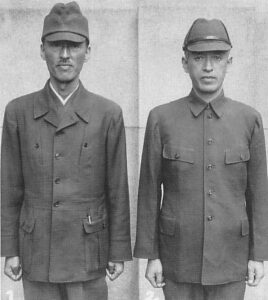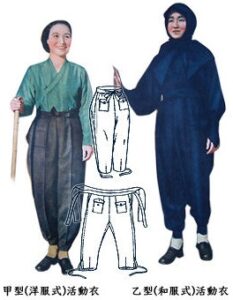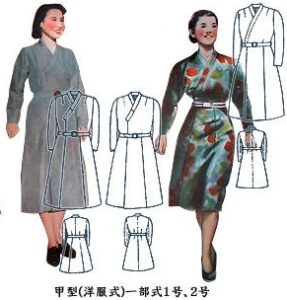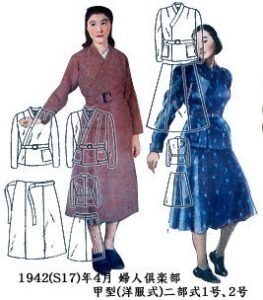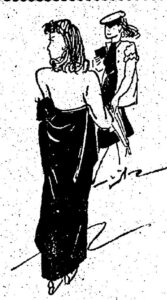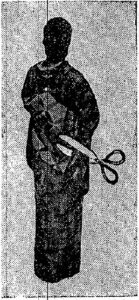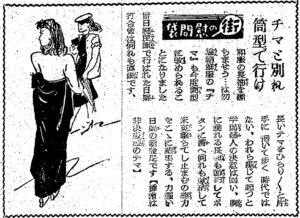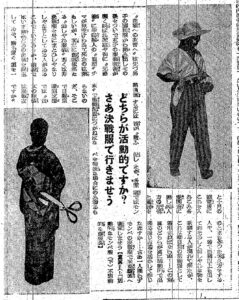In May 1945, as the war situation worsened, the Japanese colonial authorities in Korea tightened their grip on everyday life in increasingly petty and invasive ways. One striking example was the enforcement of strict wartime attire regulations. As shown in this May 14, 1945 article, colonial authorities began banning travelers from boarding trains if they were not wearing “proper” air-raid clothing, which explicitly targeted traditional Korean garments—especially the flowing chima skirts worn by Korean women.
On May 9, 1945, Keijō Nippō published a photo of the feet of Korean women wearing chima, shaming them by calling such clothing “a suicidal act.” The article warned that the skirts could easily catch fire from incendiary bombs or become soaked with water and render the wearer unable to function in a wartime emergency. The piece concluded by declaring that such a sight was inappropriate for May 8, which was Imperial Rescript Day (Taishō Hōtai-bi).
Imperial Rescript Day was a commemorative day established in 1942 during the Pacific War to boost morale across the Japanese Empire. It replaced the earlier “Asia Promotion Service Day” and designated the 8th of every month as a day for rallying national resolve to complete the war effort. On this day, subjects across the empire were expected to participate in rituals such as reading the imperial war proclamation, offering victory prayers at shrines and temples, and displaying Japanese flags at home.
Apparently, many Koreans mistakenly believed that these harsh clothing inspections applied only on Imperial Rescript Day. This would explain why the number of attire violations dropped sharply on the 8th, only to spike again afterwards.
The requirement to undergo humiliating attire checks at train stations—particularly the targeting of traditional Korean dress—would have understandably outraged many. In a time of total war, when morale should have been preserved, this kind of petty colonial micromanagement only deepened alienation and anger among the colonized.
Documenting examples like this is important. They show how colonial oppression extended into the minutiae of daily life, even into how people dressed. Far from merely logistical wartime policies, these measures were ideological tools meant to erase Korean identity, impose Japanese norms, and discipline the population into obedience. Remembering and analyzing these acts of everyday repression is not just about historical interest—it is about confronting the full spectrum of colonial violence, including the psychological and cultural forms that often go unacknowledged.
[Translations]
Gyeongseong Ilbo (Keijo Nippo) May 14, 1945
"Prohibited Attire for Boarding Trains"
Many in the Intellectual Class are Caught — One Hundred People Per Day
Sunday Special Inspection Report
Since the fourth of this month, enemy aircraft have launched continuous attacks over the seas of southern Korea. On the twelfth, six enemy flying boats penetrated the region, launching attacks on ships. The Korean peninsula is now effectively a battlefield. It is not out of the question that these enemy planes may escalate from attacks on ships to indiscriminate bombing of cities.
So, how prepared is the Korean peninsula to face this threat? Regrettably, it cannot yet be said that we are in a full wartime posture.
To take a simple example — the air-raid attire of travelers. Despite repeated warnings to the point of exhaustion, a significant number still do not wear maki-kyahan (leg wrappings), or drag long Korean-style garments that sweep the ground. Not a few have even been denied boarding by station staff. It is especially disgraceful when even members of the educated class, who should be setting an example, nonchalantly fail to wear the proper leg wrappings.
To establish a travel posture suitable for decisive battle, the Seoul Regional Bureau has, since the first of this month, prohibited boarding to travelers not in air-raid attire. From the first to the tenth at Seoul Station, 230 travelers were denied boarding.
Here is the breakdown of the numbers of passengers who were denied boarding:
-
- Day 1: 12
-
- Day 2: 8
-
- Day 3: 32
-
- Day 4: 26
-
- Day 5: 36
-
- Day 6: 48
-
- Day 7: 39
-
- Day 8: 2
-
- Day 9: 6
-
- Day 10: 21
The eighth was Imperial Rescript Day, so air-raid attire was strictly observed, with only two violations.
The highest number of refusals was on the sixth, with 48 people barred from boarding. If the general mindset is that "air-raid attire is only necessary on Rescript Days," that is a grave mistake. Enemy aircraft can appear at any time. If one can wear air-raid attire on a Rescript Day, one can certainly do so on other days.
Although unfamiliarity might be an excuse in the beginning, under normal circumstances the number of boarding denials should gradually decrease. However, judging from these numbers, there has been no reduction at all — rather, starting from the third, the number has increased, revealing a general indifference toward air-raid readiness.
Of course, the station staff are not eager to refuse boarding. If travelers are properly attired, that is enough. Station personnel issue warnings before the ticket gate to travelers who are not dressed properly. Only those who ignore these warnings are refused boarding as a last resort.
Each day, more than 100 travelers are warned, and at peak times, the number exceeds 200.
-
- Day 1: 219
-
- Day 2: 216
-
- Day 3: 187
-
- Day 4: 137
-
- Day 5: 126
-
- Day 6: 121
-
- Day 7: 117
-
- Day 8: 49
-
- Day 9: 70
-
- Day 10: 57
Without the station staff’s compassionate warnings, all these individuals would have been denied boarding outright.
It is utterly shameful that over 100 travelers each day, despite utilizing railways — regarded as weapons of war, must be reprimanded for improper air-raid attire under repeated air raids. Air-raid attire is not for anyone else — it is for the travelers’ own safety.
Travelers must take the current situation more seriously, and rather than wait to be told by station staff, they must proactively ensure proper air-raid attire.
What about the clothing of travelers arriving at Seoul Station? Unfortunately, their attire is just as inappropriate. They are not dressed for wartime travel. Although the emergency policy of “no boarding without air-raid attire” is not limited to Seoul Station but enforced throughout the entire jurisdiction of the regional transportation bureau, arriving passengers should have had their attire inspected at their departure stations.
The fact that their attire is in disarray upon arrival suggests that they shed their air-raid attire after boarding, as if thinking it is only necessary to get past boarding inspections.
This mindset must be corrected immediately. The station has announced that it will further tighten enforcement from now on.
Given the increasing severity of enemy bombing, this policy is entirely appropriate. Travelers themselves must take initiative in wearing proper air-raid clothing. Anyone wearing "unfit-for-battle attire" must be firmly excluded from our valuable wartime trains. Let us establish a decisive travel posture as soon as possible, prepared to face enemy planes at any time.
Gyeongseong Ilbo (Keijo Nippo) May 9, 1945
Can You Really Be Active Like This?
Do you really think your clothing is appropriate? Do you think you can withstand the enemy’s blind bombings dressed like that? Or is it that you do not own monpe workpants? How many times must we say that wearing chima is an act of suicide before you understand?
When incendiary bombs set your chima on fire, or when your chima becomes soaked with water, you will no longer be able to move, and you will be completely defeated.
Enemy planes may come soon—perhaps even tonight. Just because the weather has become pleasant, do not be foolish enough to think, “I will just try wearing this for a bit.” Get serious.
Even so, we still see girls strutting through the streets indulging in a sense of style, not wearing monpe, but rather sailor-style trousers—pants so fancy that even men do not wear them, once worn by revue girls. This too must stop.
If you must wear pants, tighten the hems. Also, we have seen men who are not wearing leg wrappings. That too must be corrected immediately.
The above are the unfit-for-battle appearances we observed on the Imperial Rescript Day on the 8th in a city that is under attack from frequent enemy air raids. [Photo caption: Could this be you?]
[Transcriptions]
京城日報 1945年5月14日
『乗車禁止の非服装』
多い指導層、一日に百名
日曜紙上査察
去る四日以来敵機は連日わが南鮮海面に来襲しつつある。十二日も敵飛行艇六機が南鮮海面に侵入。船舶に攻撃を加え来った半島もいまや戦場と化し敵機はいつ現在の船舶攻撃から都市の無差別爆撃に出ないとも限らないが、ところがこれに備ゆる半島の態勢はどうか。遺憾ながら、いまだ戦う態勢になりきっているとはない。
早い話が旅行者の防空服装一つをとりあげてみても、あれだけ口がすっぱくなるほど注意されながらいまだに巻脚絆をつけない者、すその長い鮮服をひきずっている者が相当数に上り、駅員から乗車を拒絶された旅行者も少なくない。殊に率先垂範すべき知識階級までが平然と脚絆をつけないでいるのはもっての外だ。
旅行の決戦態勢化を期する京城地方局では去る一日から防空服装以外の旅行者は乗車を禁止しているが、京城駅で一日から十日までに乗車禁止にあった旅行者は二百三十名に上っている。
内訳は初日の一日が十二名、二日が八名、三日が三十二名、四日が二十六名、五日が三十六名、六日が四十八名、七日が三十九名、八日が二名、九日が六名、十日が二十一名となっており、流石に八日は大詔奉戴日だけに防空服装が徹底していて禁止は僅か二名に過ぎない。
一番多いのは六日で実に四十八名が乗車を禁止されているが、一般が『防空服装は大詔奉戴日だけ』といった考えでいるとしたら大変な間違いだ。敵機はいつやって来ないとも限らないし、大詔奉戴日に防空服装が出来て他の日に出来ない筈もない。しかも最初は周知不十分ということも考えられ、本来なら漸次乗車禁止が減少する筈であるが、この数字からみると一向減少しておらず、反対に初日は少なく三日から増加している状態で、防空服装に対する一般の冷淡さをはっきりと窺うことが出来るのである。
無論、駅では乗車拒絶が本意ではない。旅行者の防空服装が整えばそれでよく、だからとくに改札前防空服装を整えていない旅行者には注意を与えており、乗車拒絶はそれでも聞かない不埒者に最後の切札として断行しているのである。
この注意を与える旅行者数をみると、これは毎日百名を下らず、多い時には実に二百名を越している。まず初日の一日が二百十九名、二日が二百十六名、三日が百八十七名、四日が百三十七名、五日が百二十六名、六日が百二十一名、七日が百十七名、八日が四十九名、九日が七十名、十日が五十七名であり、駅側のこの思いやりの注意がなければ毎日これだけの旅行者が乗車禁止になっているわけだ。
敵機連襲下に、しかも兵器といわれる鉄道を利用する旅行者が毎日百名以上も防空服装のことで駅員から注意されるのは恥辱も甚だしい。防空服装は誰のためでもない。旅行者自身のためであり、もっと真剣に時局を見つめ、寧ろ駅側からいわれる前に旅行者自ら進んで防空服装の徹底を期せねばならない。
一方京城駅に降りて来る旅行者の服装はどうか。これも乗車する旅行者と変わらず、まだまだ戦う服装になりきっていない。防空服装以外は乗車禁止の非常措置はひとり京城駅ばかりでなく、地方交通局管内全部にわたって断行されているのだし、降車客は発駅で乗車の際、一応服装を点検された筈であるが、それでいて降車の際の服装が乱れているのは旅行者が乗車してしまえば防空服装の必要なく、防空服装は乗車するためのものといった考えでいるからだ。
この考えは絶対切り換えねばならない。駅側では今後ますますこの取締を厳重にするといっている。
敵機の爆撃がいよいよ本格化しつつあるとき当然と措置であり、旅行者としても進んで防空服装を整えるよう心掛け、そして貴重な戦う列車からは断然『戦わざる服装』を締出し敵機いつでも来いの決戦旅行態勢を一日も速やかに確立することが望ましい。
京城日報 1945年5月9日
これで活動ができますか
貴女方の服装はそれでよいと思うのですか。それで敵の盲爆に戦い抜けるとでもお思いですか。それともモンペを持っていないのですか。チマのままでは自殺行為だと何度いえばわかるのです。焼夷弾でチマに火がついたとき、またはチマが水に濡れたときは活動が出来ず、あなた方は完全に負けるのです。
敵機は今に、いや今夜でも来るかも判らない季節が陽気になったから、ちょっと着て見ようなどという馬鹿気た心は起さないで真剣になりましょう。それなのにまたモンペでなくレビューガールが履いていた男も履けないセーラズボンにシャレ気分を満喫し街を闊歩する娘を見かけるが、これも止めましょう。ズボンなら裾をしぼりましょう。なお男も脚絆を着用しないのを見受けたが即刻改めましょう。以上敵機しきりに来襲する八日の奉戴日に戦う街で見受けた戦はない姿です。
【写真=あなたの姿はここにないか】
Source: National Library of Korea, Digital Newspaper Archive
See Also:
Link 1 (1943 clothing regulations regarding chima dresses): https://tpjv86b.blogspot.com/2022/11/onerous-regulations-prescribing-long.html
Link 2 (1944 police detaining a woman in Hanbok dress): https://tpjv86b.blogspot.com/2024/12/korean-woman-in-hanbok-detained-by.html
Link 3 (1945 propaganda speech forbidding rings and chima dresses at work): https://tpjv86b.blogspot.com/2025/04/dont-wear-rings-or-chima-dresses-dont.html
Link 4 (April 1945 poster shaming Korean women for wearing chima skirts): https://tpjv86b.blogspot.com/2025/05/imperial-japan-called-korean-women-in.html










